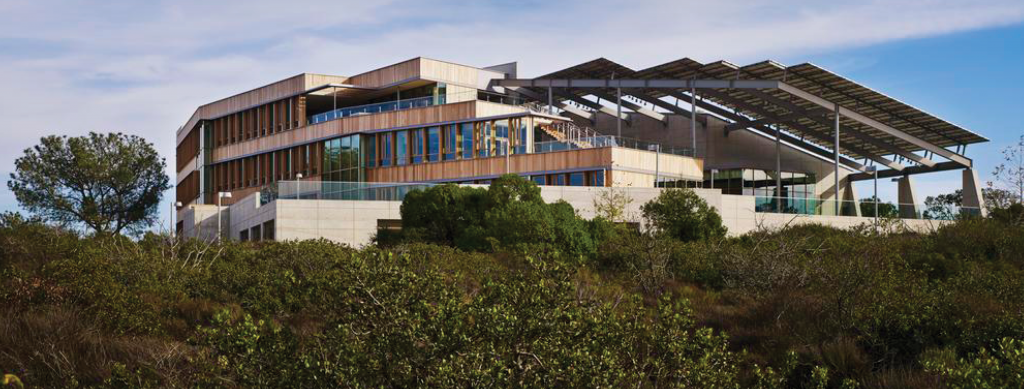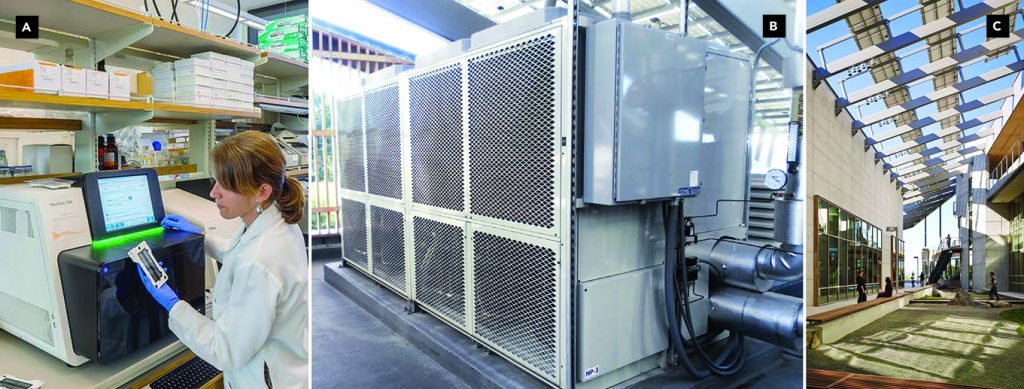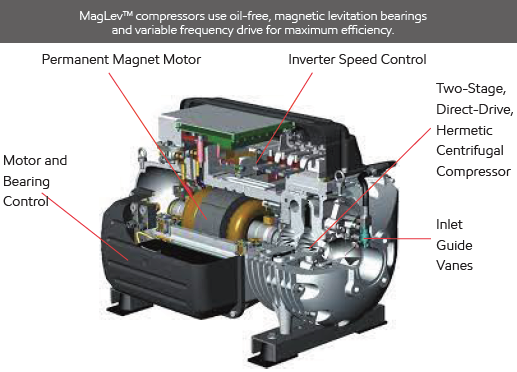J. Craig Venter Institute Achieves LEED Platinum Rating, Approaches Net Zero Energy Use
La Jolla, California
Multistack DHRC (Dedicated Heat Recovery Chiller) units can produce hot water in excess of 150F and simultaneously produce chilled water for cooling. The innovative modular design allows owners to purchase only the cooling/heating capacity needed— and easily add more capacity if needed later. The modular design also provides significant efficiency and serviceability advantages.

The J. Craig Venter Institute (JCVI), founded by renowned scientist J. Craig Venter, Ph.D., is a leader in human genomics research; environmental metagenomics research to identify microbes in the oceans, soil, and the human body; developing synthetic biology advances to better understand life; and important research into infectious disease such as Zika and influenza. Dr. Venter and his team were responsible for the historic sequencing of the complete diploid human genome and the construction of the first synthetic bacterial cell.
The Institute is not only a leader in genomics research, it respects life and the environment by using environmentally friendly and sustainable building equipment, materials and processes in virtually all respects.
Headquartered in Rockville, Maryland, JCVI started planning for a new laboratory and office building on the West Coast in 2005. The new facility, completed in 2013, is situated on the UC-San Diego campus, overlooking the Pacific Ocean.
Every aspect of the 44,600 square-feet, three-story building was designed with the environment in mind and to achieve two goals: Net zero energy use by generating on-site as much energy as the building consumes, and water conservation in the semi-arid part of the U.S. The building also achieved USGBC LEED Platinum designation. These goals were met using a multi-faceted approach to building design and construction:
Thermal Energy Storage (TES) system for heating and cooling using Multistack air- and water-cooled chillers, and heat pump systems
- 26,124 Square-feet of photovoltaic surface in two arrays and 1,488 panels generate enough electricity to meet almost the entire annual demand
- Use of natural daylight with sensors to detect when additional lighting may be needed
- Operable windows for natural, passive ventilation
- 95,000 Gallon rainwater collection system provides water for toilet flushing, irrigation, and cooling tower makeup— supplying more than half the building’s annual water use
All construction materials were selected not only for performance, efficiency and aesthetics, but also for sustainability and minimal environmental impact. Features include high-performance windows, Spanish cedar cladding and quickly renewable interior materials such as bamboo flooring. The high-strength concrete includes 30 percent fly ash to increase recycled materials use and reduce the energy needed for construction. The cedar cladding was sourced from renewable forest and left untreated to eliminate chemical finishes.
Photovoltaic cells on the roof not only generate electrical energy, but their location provides shading to help reduce heat gain and cooling requirements. Under-building auto parking is provided along with bike racks, rest rooms and showers to promote the use of alternative transportation methods.
Let There Be Light
The overall orientation of the building on an east-west axis allows for excellent day lighting to reduce energy consumption for lighting. The building’s narrow configuration provides the most glass area on the south and north exposures, while reducing glass area on the west side that would otherwise result in afternoon heat load.
A Heating and Cooling Challenge
Passive strategies include enhanced wall and roof construction and natural ventilation. Enhanced wall and roof construction allows the mechanical system to be smaller, which decreases first cost and minimizes architectural/ structural challenges. JCVI’s natural ventilation strategy uses manually operable windows, allowing occupants to actively adjust their office environment for comfort and eliminate both the first-cost and the maintenance requirements of window actuators. Gentle breezes from the Pacific Ocean and the temperate climate of La Jolla greatly reduce the hours of active system operation.
However, there are days where an active system is required to provide heating and cooling to ensure occupant comfort and productivity. JCVI’s active HVAC system includes induction diffusers and a dual-temperature chilled water loop and hot water system. Induction diffusers are served by a dedicated outside air system that brings only fresh outdoor air into the building without recirculated air. The benefit of such a system includes smaller ductwork and less sheet metal, smaller fans and air handling units. The dual-temperature chilled water loop provides dehumidification and cooling at the induction diffusers. The hot water system provides heating at the induction diffusers and serves both domestic and industrial hot water systems.

A: JCVI staff at DNA Sequencer. B: A Multistack ASP air-to-water heat pump installed at JCVI. C: Rock garden in courtyard at JCVI, La Jolla, California.
JCVI Features Advanced HVAC Products from Multistack
Multistack Dedicated Heat Recovery Chiller (DHRC)
- Easy installation for virtually any mechanical room
- COP can exceed 7.0 by leveraging combined chilled and hot water efficiency — more efficient than a gas-fired boiler at 0.95 COP !
- Typical payback less than three years
- High efficiency at low load
- Reduced CO2 emissions
- Qualifies for USGBC LEED® points
- ASHRAE 15/B52 compliant without monitoring or ventilation equipment
MS080T Centrifugal Chiller
- Leading edge technology MagLev™ compressor with oil-free magnetic levitation bearings
- Quieter than typical background noise
- Soft start—only 2 amps at 460 V
- Superior part load efficiency with integrated VFD control
- Environmentally friendly R-134a refrigerant; low refrigerant volume qualifies for LEED EA credit
ASP Air-Cooled Heat Pumps
- COP levels of up to 4.1. Multistack heat pumps are among the most efficient in the industry
- Digital controls and multiple modules and compressors to closely match actual operating loads for best efficiency and significantly reduced energy consumption compared to single compressor units
- Can help owners achieve USGBC LEED points and energy credit.

“Multistack heat pumps are an effective, efficient and integral part of the heating and cooling system that helps the building operate extremely efficiently and help achieve the zero net carbon goals and sustainability objectives.”
J. Craig Venter Institute HVAC System Operation
The JCVI mechanical system achieves its high efficiency by using the thermal energy storage (TES) system as a giant energy storage battery and then using the most efficient source of cooling and heating to supplement the TES.
At night when heating is needed, the Multistack water-to-water heat pump is used to generate heating hot water while the cooling water generated is used to cool the TES system. During the night, if additional cooling is needed for the TES, the cooling towers can operate to meet this load.
Throughout the day, the building draws chilled water from the TES to cool the building. If the TES runs out of capacity, the cooling towers and Multistack chillers operate to maintain chilled water temperature and satisfy building cooling requests. As chilled water is drawn from the TES, it is replaced with warm water for use in heating at night.
Operating the cooling towers at night has several advantages:
1) Rejecting heat to the cool night air is more energy efficient
2) More hours using free cooling without operating the chillers
3) Less drift from the cooling towers results in water savings
4) Electric rates are less expensive at night
The Multistack water-to-water heat pump sold by Air Treatment Corporation operates to simultaneously generate medium temperature chilled water to cool the internal loads and hot water for areas of the building requiring heating. In addition to the simultaneous generation of hot and chilled water, the water-to-water heat pump also heats the domestic and industrial hot water storage tanks. The heat pump operates at a COP of approximately 6.0 or higher, using one unit of electricity for six units of heat produced.
During peak winter conditions, and if the TES tank is no longer warm enough to be used as a heat source for the water-to-water heat pump to generate hot water, an air-to-water heat pump, also from Multistack, generates hot water (120F for heating hot water and 140F for domestic and industrial needs) to serve as a heating system backup. The air-to-water heat pump operates at a COP of 2.4, using one unit of electricity for 2.4 units of heat produced. This reduces energy required to provide heating to building occupants, as compared to typical buildings where gas fired boilers at a COP of 0.85.
The Multistack MS080T MagLev®
chillers operate when dehumidification of the outside air to the air handlers is needed. A separate 45 F loop provides dehumidification at the air handler chilled water coils. Hot water rejected from these chillers is stored in the TES for night heating use.



